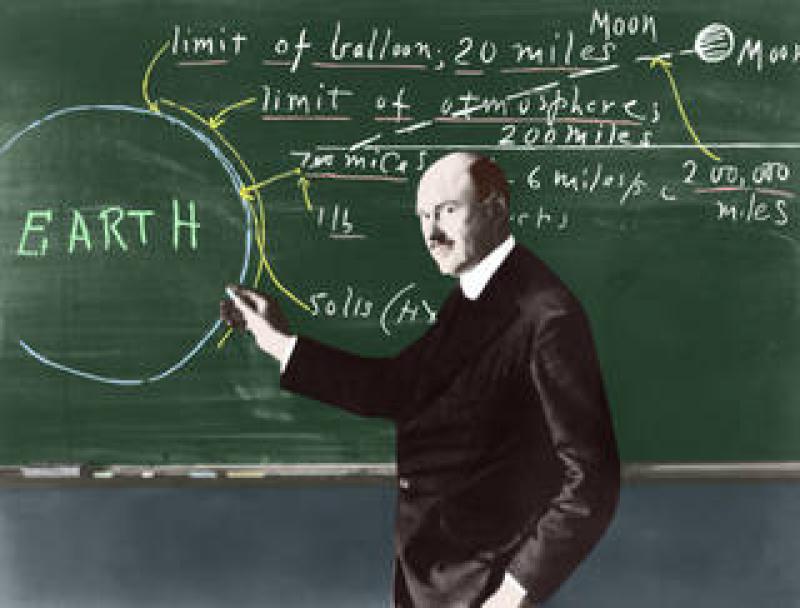Lesson Plan

Robert Goddard
Concept / Topic To Teach:
Chemical and/or physical reactions can be harnessed and directed to cause motion.
Grade Level:
3 to 5
Standards Addressed:
Ohio Academic Standards Science:
Grade 4: Nature of Matter, 2. Identify characteristics of a simple chemical change. When a new material is made by combining two or more materials, it has chemical properties that are different from the original materials (e.g. burning paper, vinegar and baking soda)
Grade 4: Forces and motion, 3. Identify contact/non-contact forces that affect motion of an object (e.g., gravity, magnetism and collision)
Duration:
90 minutes
General Goal(s):
Students will gain the knowledge that a directed force caused a force in the opposite direction. (Newton’s Third Law)
Specific Objectives:
Students will become familiar with reaction of carbon dioxide in a closed container.
Students will become familiar with the reaction of air presser in when forced in one direction.
Students will become familiar with the elasticity of rubber when forced in one direction.
Required Materials:
35 mm film cans, balloons, string, tape, foam tube rocket kits, mentos (regular) 2 liter and 12 ounce plastic bottles of diet cola, water, Alka-Seltzer , rubber bands, and Safety Glasses.
Primary Sources Used:
Photos of Robert Goddard with first rockets developed in the 1930’s
Warm-up:
Discuss the nature of rockets; Fourth of July Fireworks and rockets, Robert Goddard as an American pioneer in rocket propulsion systems, John Glenn and Space flight, rocket propulsion systems, and safety procedures.
Step-By-Step Procedures:
Construct “rockets”
1. Place one Alka-Seltzer tablet in a film can with water, close and observe the reaction.
2. Place 5 mentos in a 2-liter bottle of diet cola, close and observe the reaction.
3. Using foam rockets, stretch the rubber band from index finger on left hand to rocket held in right hand release.
4. Blow up a balloon, attach a straw to the balloon with tape, tread a string through the straw, stretch the string tight, release the balloon.
Homework and Practice:
Repeat procedures 1, 2, 3 and 4.
Closure (Re-teach):
Discuss each of the four procedures. Repeat individual procedures if students indicate uncertainly about the reaction that took place.
Assessment Based On Objectives:
Ask students to restate the sequence of events for each type of “rocket”.
Adaptations (For Students With Learning Disabilities):
The teacher will provide one to one and small group instruction if informal assessment shows the students needs further practice.
Extensions (For Gifted Students):
Students will be given the opportunity to construct a solid fuel rocket kit.
Students will be given the opportunity to write a science fiction story about travel to another planet.
Students will be given a web quest in the area of Rockets and how they have and will continue to influence the American people.
Possible Connections To Other Subjects:
- Write a sequential description of any or all of the rockets made.
- Write a letter to NASA and ask for free materials about rockets.
- Use math skills to estimate and chart time and length of rocket flights.
- Problem solve how to increase/ decrease the physical and chemical reactions needs to fuel rockets.
- Consider how rockets have changed our society.
- Role play an interview with Robert Goddard. Ask the following questions. Use Internet resources to find the answers before the interview.
1. How did your interest in rockets begin?
2. What were some of the turning points in your work?
3. What personal sacrifices did you have to make?
4. How did World War II affect your work?
5. What was your part in the beginning of NASA?
6. What did you leave undone?
Resources for Lesson on Rockets:
The father of modern rocket propulsion is the American Robert Goddard.
On October 5, 1882, Nahum Danford Goddard, a businessman, and Fannie Hoyt Goddard delivered a son, Robert, in Worcester, Massachusetts.
Dr. Goddard's liquid oxygen-gasoline rocket was fired on March 16, 1926, at Auburn, Massachusetts. It flew for only 2.5 seconds, climbed 41 feet.
Robert Goddard was granted two U.S. patents for rockets using solid fuel, liquid fuel, ... Robert Goddard - The First Rockets and Robert Goddard.
The original rocket, designed and built by rocket engineering pioneer Robert H. Goddard in 1926, opened the door to modern rocketry.
Robert Hutchings Goddard was born in Worcester, Massachusetts.
Accessible online from Clark University's Robert Hutchings Goddard Library.
Submitted by John Anderson
